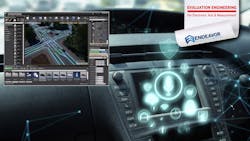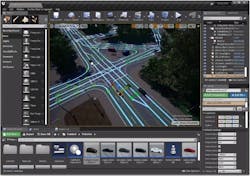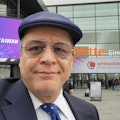Accelerating ADAS and Autonomous Vehicle Development
This article appeared in Evaluation Engineering and has been published here with permission.
What you’ll learn:
- Automotive development issues.
- ADAS and autonomous vehicle test demands.
- How simulation can aid development of advanced systems.
The automobile is at the focus of just about every advanced technology currently being developed, from artificial intelligence to next-generation wide-bandgap semiconductors. Bringing all of the disparate yet complementary functionalities available together in one solution is the hard part. Powerful software simulation is one way to address this demanding evaluation task.
Recently, NI acquired monoDrive, a leader in advanced high-fidelity simulation software for advanced driver-assistance systems (ADAS) and autonomous vehicle development. NI will leverage monoDrive’s signal processing and advanced simulation tech to create high-fidelity driving environments, modeling multiple sensors in thousands of real-time scenarios. Combined with NI’s software-connected systems, it will better integrate simulation, lab-based, and physical testing environments (see figure).
NI also announced a strategic collaboration with Ansys, whose simulation solution enables sensor vendors to simulate radars, LiDARs, and cameras recreating real-world simulation to validate sensors and inject data into software and hardware under test in real time. This shared focus combines Ansys’ physics-based sensor simulation solutions and NI’s driving simulation and testing infrastructure to enable the rapid development of improved ADAS technology. To get a better insight into these developments and what they can mean for the industry, we spoke to Noah Redding, Senior Director, Solutions and Offering Management at NI.
EE: Noah, you have a great title, “Director of Solutions.” It must be a blessing and a curse. The word solution is such a humongous, nebulous term, right? Your title is a great place to start because that’s the dilemma of every engineer, right? What is a solution? How do we get there?
Noah Redding: Yes, definitely. Maybe I can give you a little bit of background on my role and what I do here at NI. I manage our transportation business unit, where we are working with automotive customers and OEMs, Tier 1 suppliers, Tier 2 suppliers, all through the value chain. The part of the business that I look after, is how do we bring solutions and systems and solve customer challenges as they’re in the design, research, and validation phases?
So you can view it as pretty much everything that they’re doing before they get to manufacturing and production, as they’re working through these challenges of developing really complex and sophisticated automotive electronics and different types of systems. How do we meet them where they are, through solutions to help test and validate and bring those systems to market sooner? Also, knowing that quality is going to be non-negotiable, we also help them make sure that those products are extremely high quality.
EE: The interesting aspect is once we start with that big solution, we have to drill down very specifically, because every solution has a name, but also a category and a bin and all of this other. Isn’t there a lot of blurring going on now? With the cloud and IoT and edge computing and AI, you can take all the buzzwords and shake them up in the basket. But at the end of the day, it also means that a lot of systems are much more interrelated. That means you need someone who knows electromechanical, you need someone who knows RF, you need someone who knows all of the various things related to the solution, or at least find partners who know these things. Right?
Redding: Absolutely. That’s a great way to put it, and to be honest, when you look at it, we said we were going to talk a little bit more about our acquisition of monoDrive. If you take a step back, the scenario you’re painting is very real and it’s a really complex problem that’s happening in the automotive industry right now. The ADAS and autonomy space has only magnified that issue, because you’re talking about the systems that are working together.
You’ve got different parts of the vehicle that have to talk to each other, and make new types of decisions that the vehicle has never made before. It creates this challenge where there’s basically an endless, infinite number of scenarios, and things that automotive companies are having to figure out. How do we test and validate that the vehicle is going to be able to process this type of situation?
For example, if a car is driving on the freeway, and there’s a situation where there is a dog, and then there’s a car, and then there’s construction. What does the car decide? So, there’s this infinite state space of scenarios, and so you have to bring these different expertises together. In this ADAS and autonomy space, what we see is there’s a real workflow challenge that people are working through.
It’s not just the different disciplines like you mentioned, but also, for example, if you’re going to produce a high-quality vehicle or component, a lot of companies are trying to figure out “how do I actually test in the right amount, from a pure simulation environment, to lab-based testing, on to road testing?” And finding the right mix of that is a real challenge. So, what we’re doing is working with our customers to unify that workflow and make going between those different phases as seamless and easy as possible.
EE: That’s a huge juggling act. One of the areas where you really see it is in RF, because RF is often the last new thing added to a device, as it were. A developer pointed out to me that often, a customer will come to you asking for advice on putting the RF into the device. They know everything about the device, they’re an expert in that aspect of it, but they know nothing about the RF that has to go into it.
Redding: I think that’s a great example. RF components are one piece of it. So, if you look at the vehicle, you’ve got traditional automotive components, and now you’ve got enhanced requirements as we go through L2, L3, L4 stages of autonomy. We’re now bringing in the electromechanical components, having them work with RF devices that are communicating with other cars, that are communicating with cellphone towers, and that are also communicating with different components in the vehicle.
Now, you have to bring together, like you said, these different pieces and different disciplines. It’s not just, “Okay, I’m going to put my pedal on a brake,” and then mechanically, the vehicle is going to slow down. That’s all done electronically now, but it’s also the decision-making. This is actually where we see some of the biggest challenges, because it’s not just bringing together physical components, you have to bring a sophisticated decision algorithm that has been developed, with some machine-learning capabilities built into the algorithm itself.
Now, how do you merge electronic systems with a mechanical thing, like a blinker that shows which direction you're going to turn, while also deciding when and how to brake the vehicle? The analogy of different disciplines is great because the integration issue not just electrical and mechanical, it's also software-based. It's this explosion of different scenarios and capabilities that companies are trying to figure out how to properly validate.
For our approaches, we want to be working with industry leaders and experts, and bring that together to give our customers a more complete solution, which is why you see things like an acquisition of monoDrive. Now they’re a part of the NI family, so bringing those two together is going to bring value to our customers, while also partnering with a company like Ansys. It’s really leveraging that industry expertise and recognizing that we can’t do everything, but if we can bring together the right people who know how to do it, then we can give our customers a better solution.
So monoDrive is officially part of the NI family now, and basically, if you zoom out a little bit, what you may hear in the automotive industry is this concept of Vision Zero, this common sense of purpose and goal for the industry, a goal of zero accidents, zero emissions, and zero congestion. If you look at Vision Zero from an NI standpoint, the pace of innovation to achieve that vision is incredible in the automotive industry right now.
What that means is that companies are trying to get cars out fast, and they’re trying to release new features and capabilities, but they also have to do it without negotiating on quality. So the reality is, in order to get to Vision Zero, there can be no shortcuts, you’ve got to help people accelerate that timeline, but you can’t take a shortcut to minimize the quality. So when we look at what Vision Zero means for autonomous vehicles, it creates this challenge and kind of a natural tension. I want to release these vehicles and these capabilities quickly, but I have to make sure that it’s high quality, so how do I do that in the right manner?
So monoDrive has some unique capabilities as a company. We’ve partnered with monoDrive for several years now, and what they do is they provide really powerful and high-fidelity virtual environments that are capable of modeling dozens of sensors in real time. That can be used for cloud-based simulation as well as hardware-in-the-loop or lab-based tests. So their capabilities, combined with our platform of connecting physical IO interfaces in a real-time operating system, allows our customers to do high-fidelity simulation and modeling, and actually connect up to the device itself.
So, like I was saying earlier, they have this workflow challenge where NI plus monoDrive will allow them to go from pure simulation-based testing to lab-based testing pretty seamlessly, and so that capability is going to help our customers test more and more scenarios. Because what’s clear is, with infinite testing scenarios, the only way to get the right amount of coverage and to perform enough tests to where you’re making sure the vehicle is performing as you expect it, is you have to have some sort of simulation. You’re not going to be able to do everything on the road. It would just be too expensive and it would take too long.
EE: That presents its own set of issues, right? Because we have to think about over-the-air measurements and the like, because a future scenario, smart city, smart traffic, telematics, V2X space, it’s going to be a very crowded RF spectrum out there. It’s already a crowded RF spectrum, so you really have to ensure that your test environment is accurate to real-world conditions. When it comes to that aspect of test chambers, over-the-air measurements, and the like, what are some of the challenges you see and how are you addressing them?
Redding: The types of conversations that we’re having with automotive OEMs as well as their suppliers is the same question, it’s the same challenge. For example, in RF, I know I’ve got to do some over-the-air testing, but at the same time, I don’t know if I need to do all of it that way, and if that’s the only way I’m going to test. How can I simulate in a virtual environment some of those interactions, and what will happen with those sensors, and with the vehicles, so that I don’t have to actually go do some of that over-the air-testing?
That’s kind of the fundamental question, because if you think about whether it’s RF testing or it’s logging data inside the car, or on the test track, or on the road, that’s more expensive. It takes more space, it takes more time, you have to have prototype vehicles, and to your point, you have to build a chamber, and you’ve got to have these physical assets that are performing certain tests.
But the reality is that’s pretty expensive, and can take a decent amount of time, or can take more time, and it also utilizes physical assets that are going to be a limiting and a gating factor. So, a lot of these companies know they need to do some of that, but how to do less of that, and more in the lab, with maybe some simulated environments around it? Or even less of that, and just pure simulation. Fundamentally, that’s the crux of the question.
If you take, for example, the automotive industry, let’s go back several decades. It was kind of the same question, when the electronics in the vehicle were all about controlling a combustion engine, and the emissions, and tuning a vehicle, and tuning the engine. The industry actually went through the same type of question, and went through the same process then, because there was a lot around “how do we tune the engine to perform in a certain way?” Okay, we’re going to take it out on the road, but that’s kind of expensive, and prototype vehicles are hard and so are prototype engines, it’s expensive and time consuming.
You started to hear about this concept of hardware-in-the loop tests. “Okay, we’re going to take a controller for an engine, and we’re going to simulate the engine around it, because I don’t actually have the engine with me.” But that way, I can still perform development and speed up the process. Now it’s basically the same question, just not applied to combustion engines, but it’s applied to the vehicle as a whole, and how does it operate autonomously? Which is infinitely more complex than just an engine because you have all of these different systems working together.
EE: A lot of moving parts, no pun intended.
Redding: If you take the fundamental problem of infinite scenarios to test, the only way you can do that in a scalable way is you’ve got to be able to do some sort of simulation, whether it’s pure cloud-based simulation, or you’re simulating some components in the lab but other components are physical. So first and foremost, monoDrive has unique capabilities for doing that. It offers pure simulation, and then you can take those models and run it on our real-time platform in a lab, to where now you’re doing hardware and a loop-based simulation. So you may have an ADAS ECU, but you don’t have the rest of the vehicle, and you’re simulating the car around it.
monoDrive also had some capabilities, without getting too much into the technical details, where you can take real-world data, where you take a car out on the road, you record it, and then you can actually create digital twins from that data. So now, you’re using real data to actually create a virtual environment to do more simulation, and do more testing earlier in the process. So again, you can kind of see this workflow from pure simulation to part simulation to road based test, and our goal is to make that intersection as easy as possible. monoDrive brings some unique capabilities that help with real-world data, bringing it down into virtual environments, and then adding high-fidelity models to that to allow you to do lab-based simulation.
The challenge is when you’re on a test track, you’ve got a few known scenarios but it’s kind of impossible to cover the full gamut of driving situations and capabilities. How do you simulate all of the different traffic scenarios and all of the different downtown-driving scenarios with pedestrians and crosswalks and things like that? Basically, you can do a lot of development and test and validation, and create some scenarios in those types of controlled environments, whether they’re indoor, you have a full vehicle in there, or you’re doing it on a track.
But that’s only part of the problem, because you can only recreate a subset of real-world scenarios. Inside this test track, I’m going to do these 100 scenarios, when in reality, when the car is on the road, you’re going to have millions of different situations that it could come across. You could be really good in those 100 scenarios, but for the other 999,000, how do you get confidence in those?
That’s where we’re going to go out and drive on the road, we’re going to record a bunch of data, and then re-create some scenarios virtually, or we’re going to do a pure software-based simulation on the cloud, where we know we can run through millions of scenarios and just keep the simulations running constantly. It’s that type of balance of simulation versus real, and utilization of assets that companies are going through right now.
EE: Do you have any final thought or point or something that we hadn’t covered yet that you wanted to leave our readers with?
Redding: The problem is the challenges that our customers are facing are limitless, and they can be seemingly infinite in terms of the types of things you’re going to have to work through. What we find our customers are really trying to do is try and find that balance between real-world testing, lab-based testing, and pure simulation-based testing. The truth is there is not one company that can do everything for automotive companies to help them validate those systems. It’s got to be a collection of experts that bring different levels of experience and capabilities to help our customers achieve that Vision Zero.
About the Author
Alix Paultre's Archive
Editor-at-Large
Also check out Alix's main author page for his latest articles.
An Army veteran, Alix Paultre was a signals intelligence soldier on the East/West German border in the early ‘80s, and eventually wound up helping launch and run a publication on consumer electronics for the US military stationed in Europe. Alix first began in this industry in 1998 at Electronic Products magazine, and since then has worked for a variety of publications in the embedded electronic engineering space. Alix currently lives in Wiesbaden, Germany.
Also check out hjis YouTube watch-collecting channel, Talking Timepieces.



